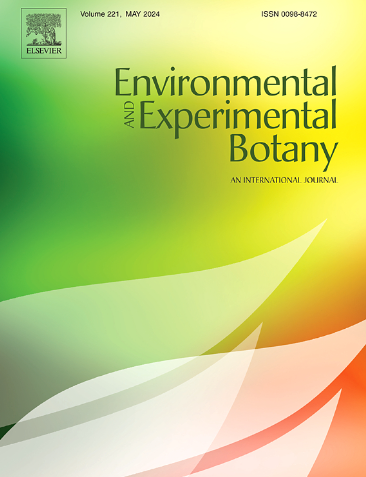亚热带次生常绿阔叶林对酸沉降和钙添加的不同响应:来自蒸腾和水分利用效率动态的实验证据
IF 4.7
2区 生物学
Q2 ENVIRONMENTAL SCIENCES
引用次数: 0
摘要
长期的酸沉降导致土壤严重酸化,导致钙(Ca)的耗竭和植物毒性铝(Al)的积累。钙是植物感知水分胁迫、强化细胞结构和提高水分利用效率所必需的,而铝则损害根系功能。因此,改变的土壤Ca和Al动态可能对植物水分利用和水分利用效率产生不同的影响,但其潜在机制尚不清楚。为了探讨这一问题,我们于2022 - 2024年在中国南方一片次生常绿阔叶林进行了土壤酸化(Acid)和钙修正(Ca)的模拟野外试验。本研究对4种优势种Pyrenaria macrocarpa、Quercus myrsinifolia、Aporosa dioica和Castanopsis fissa的蒸腾作用进行了连续监测,并分析了其δ¹ ³c衍生的内在水分利用效率(WUEi)。此外,我们还进行了定期的生态生理测量,包括土壤和叶片化学计量、叶片水势和气孔导度。结果表明,对酸和钙处理均有物种特异性反应。2022年和2023年,粗叶茅蒸腾量变化不显著,但2024年显著下降,提示累积Al的延迟毒性效应。与此相反,雌黄在酸处理下蒸腾量持续增加,可能反映了酸性土壤维持养分吸收和支持光合作用的适应性策略。两种植物的土壤钙含量和叶片钙铝比均显著增加,且与土壤钙含量和叶片钙铝比呈正相关。与之相比,两种处理均无显著的生理反应。这些发现突出了共存优势种对酸沉积和钙修正所采取的不同策略。长时间的酸沉积可能会威胁到像P. macrocarpa这样的物种,而光合作用和水分需求高的物种,如A. dioica和C. fissa,在酸化和干旱的联合胁迫下,可能面临更大的水力衰竭风险。本文章由计算机程序翻译,如有差异,请以英文原文为准。
Divergent responses to acid deposition and calcium addition in a subtropical secondary evergreen broadleaved forest: Experimental evidence from transpiration and water use efficiency dynamics
Chronic acid deposition has induced severe soil acidification, leading to the depletion of calcium (Ca) and the accumulation of phytotoxic aluminum (Al). Ca is essential for sensing water stress, strengthening cellular structures, and enhancing plant water use efficiency (WUE), while Al impairs root function. Consequently, the altered soil Ca and Al dynamics are likely to produce divergent impacts on plant water use and WUE, yet the underlying mechanisms remain poorly understood. To investigate this, we conducted a manipulative field experiment simulating soil acidification (Acid) and calcium amendment (Ca) in a secondary evergreen broadleaved forest in South China from 2022 to 2024. We continuously monitored sap flow-based transpiration and analyzed the δ¹ ³C-derived intrinsic WUE (WUEi) in four dominant species: Pyrenaria macrocarpa, Quercus myrsinifolia, Aporosa dioica, and Castanopsis fissa. Additionally, we conducted periodic ecophysiological measurements, including soil and leaf stoichiometry, leaf water potential, and stomatal conductance. The results showed that species-specific responses to Acid and Ca treatments. P. macrocarpa exhibited no significant change in transpiration under the Acid treatment in 2022 and 2023 but showed a significant decline in 2024, suggesting a delayed toxicity effect from accumulated Al. In contrast, A. dioica consistently showed increased transpiration under the Acid treatment, potentially reflecting an adaptive strategy to maintain nutrient uptake and support photosynthesis in acidic soils. Both species showed a significant increase in WUEi with Ca amendment, positively correlating with soil Ca content and leaf Ca/Al ratio. In comparison, Q. myrsinifolia and C. fissa displayed no significant physiological responses to either treatment. These findings highlight the divergent strategies adopted by co-occurring dominant species in response to acid deposition and Ca amendment. Prolonged acid deposition may threaten species like P. macrocarpa, while species with high photosynthetic and water demands, such as A. dioica and C. fissa, may face increased risk of hydraulic failure under the combined stressors of acidification and drought.
求助全文
通过发布文献求助,成功后即可免费获取论文全文。
去求助
来源期刊

Environmental and Experimental Botany
环境科学-环境科学
CiteScore
9.30
自引率
5.30%
发文量
342
审稿时长
26 days
期刊介绍:
Environmental and Experimental Botany (EEB) publishes research papers on the physical, chemical, biological, molecular mechanisms and processes involved in the responses of plants to their environment.
In addition to research papers, the journal includes review articles. Submission is in agreement with the Editors-in-Chief.
The Journal also publishes special issues which are built by invited guest editors and are related to the main themes of EEB.
The areas covered by the Journal include:
(1) Responses of plants to heavy metals and pollutants
(2) Plant/water interactions (salinity, drought, flooding)
(3) Responses of plants to radiations ranging from UV-B to infrared
(4) Plant/atmosphere relations (ozone, CO2 , temperature)
(5) Global change impacts on plant ecophysiology
(6) Biotic interactions involving environmental factors.
 求助内容:
求助内容: 应助结果提醒方式:
应助结果提醒方式:


